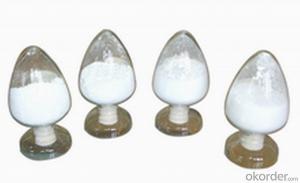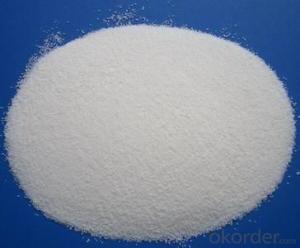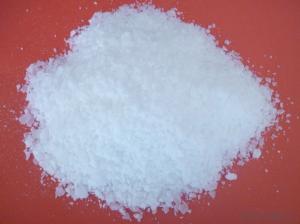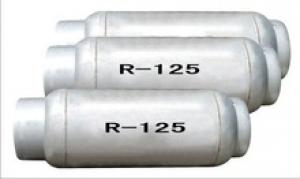Stearic Acid 1668
- Loading Port:
- Tianjin
- Payment Terms:
- TT OR LC
- Min Order Qty:
- -
- Supply Capability:
- 8000MT/month m.t./month
OKorder Service Pledge
OKorder Financial Service
You Might Also Like
Stearic acid
Formula: C18H36O2
Structural Formula:CH3(CH2)16COOH
Product Description:
Shaped like Lump, flake; Saturated fatty acid mainly with C16 and C18, white flake solid at ambient temperature, not dissolved in water, slightly dissolved in benzene and carbon bisulfide, and easily dissolved in hot alcohol. No smell no poison. It has the general chemical properties of organic carboxylic acid.
Physicochemical Properties:
pure product is white with a shiny soft small pieces, melting point 69.6 degrees, the boiling point of 376.1 degrees. Relative density 0.9408, refractive index 1.4299, slowly volatile in the 90-100 degrees. Slightly soluble in cold water, soluble in alcohol, acetone, soluble in benzene, chloroform, ethyl ether, carbon tetrachloride, carbon disulfide, toluene and so on.
Specification:
Item | Index | |||||
Grade No. | 1842 | 1838 | 1820 | 1860 | 1870 | 1880 |
Iodine value gI2/100g ≤ | ≤5.0 | ≤5.0 | ≤5.0 | ≤6.0 | ≤7.0 | ≤8.0 |
Saponification value mgKOH/g | 206~211 | 206-213 | 214-216 | 193-220 | 193-220 | 192-218 |
Acid value mgKOH/g | 208~210 | 210~211.5 | 214-225 | 182-218 | 192-218 | 193-220 |
Chroma (Hazen) ≤ | ≤60 | ≤80 | ≤100 | 200-400 | ≤150 | 400 |
Freezing point °C | 54~57 | 54~57 | 55~57 | 54 | 52 | 52 |
Moisture % ≤ | ≤0.2 | ≤0.2 | ≤0.2 | ≤0.3 | ≤0.3 | ≤0.3 |
Inorganic acid % ≤ | 0.001 | 0.001 | 0.001 | 0.001 | 0.001 | 0.001 |
Suggest Uses:
Mainly for the production of stearic acid salts: Widely used system for cosmetics, plastic cold-resistant plasticizer, release agent, stabilizer, surfactants, rubber vulcanization accelerator, waterproof agent, polishing agent, metal soap, metal mineral flotation agent, softeners, pharmaceuticals, and other organic chemicals.
In addition, oil-soluble pigments can be used as solvents, crayons transfer slip agent, waxed paper lighting agent, stearic acid glyceride emulsifier, etc..
Packing :25/50kg in PP bag ,25MT/20GP
Product Storage:
in dry warehouse ventilation should be more than 10mm from the ground to avoid damp products in the above-mentioned conditions, from the date of delivery for one year shelf life.


- Q: Can the carboxylic acid react with sodium?
- can
- Q: The main role of sugar?
- Carbohydrates as an important body of nutrients, mainly divided into four categories: monosaccharides, disaccharides, oligosaccharides and polysaccharides.
- Q: What are the inorganic compounds
- The inorganic compound is a compound other than an organic compound. Organic compounds are organic matter containing C (carbon), in addition to CO2, carbonated, carbonate-containing.
- Q: What is the difference between organic matter and inorganic matter?
- Inorganic matter is an inorganic compound. Generally refers to the elements other than carbon elements, such as water, salt, sulfuric acid, lime and so on. However, some simple carbon compounds such as carbon monoxide, carbon dioxide, carbonates, carbonates and carbides, because of their composition and properties and inorganic similar, so also as an inorganic to study. The vast majority of inorganic matter can be classified as oxides, acids, alkalis and salts.
- Q: What happens to the neutralization reaction?
- The neutralization reaction takes place with the hydrogen and hydroxide groups of the acid and base. The carboxylic acid group contains hydrogen ions to react with the hydroxide.
- Q: Is fatty acid and carboxylic acid the same thing?
- In contrast, aromatic acids refer to carboxylic acids with benzene rings
- Q: Are hydrocarbons all organic?
- A series of organic compounds, also known as "hydrocarbons." Many types, according to the structure and nature,
- Q: What is a derivative?
- Derivative refers to a compound formed by the substitution of atoms or radicals in a parent compound molecule by other atoms or radicals, known as derivatives of the parent compound. Derivatives named, the general parent compound as the main body, with other groups as a substituent. Such as: halogenated hydrocarbons, alcohols, aldehydes, carboxylic acids can be seen as derivatives of hydrocarbons, because they are hydrogen atoms of hydrocarbons are replaced by halogen, hydroxyl, oxygen and other products
- Q: Is the heterocyclic compound not a derivative of cyclic hydrocarbons? why?
- Aromatic hydrocarbons referred to as "aromatic", usually refers to the molecules containing benzene ring structure of hydrocarbons. Is a kind of closed-chain class.
- Q: Organic chemistry, carboxylic acid derivatives are not acid?
- Not necessarily
Send your message to us
Stearic Acid 1668
- Loading Port:
- Tianjin
- Payment Terms:
- TT OR LC
- Min Order Qty:
- -
- Supply Capability:
- 8000MT/month m.t./month
OKorder Service Pledge
OKorder Financial Service
Similar products
Hot products
Hot Searches
Related keywords

























